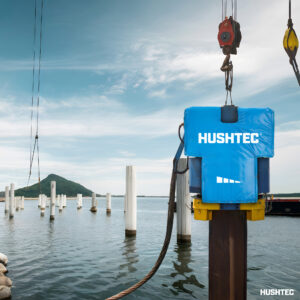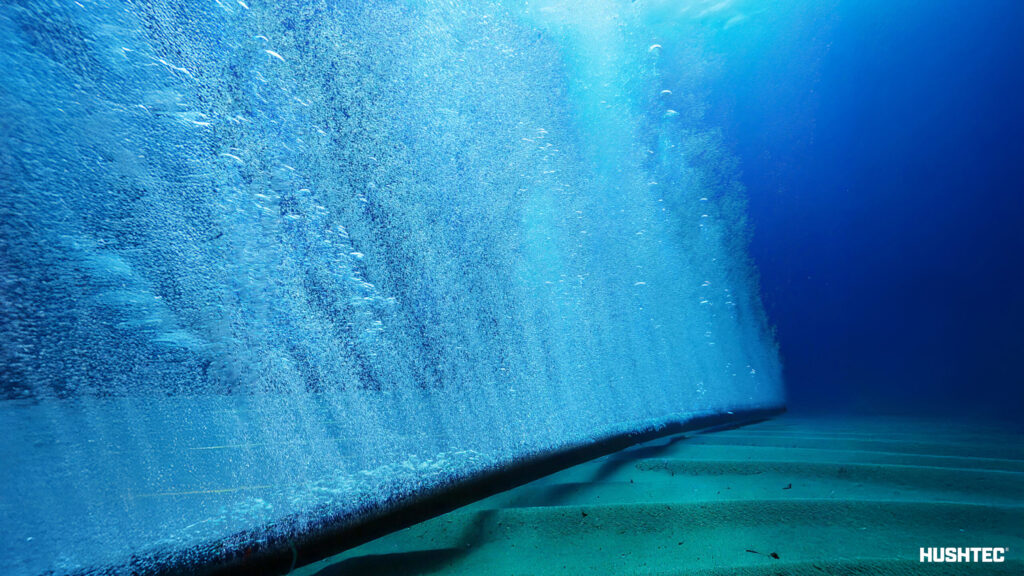Noise pollution marine life is now recognized as one of the biggest threats to our oceans. Human-made sounds—from shipping and seismic surveys to offshore construction—are disrupting ecosystems and threatening the survival of marine species. This article explores the impact of ocean noise pollution, its effects on wildlife, and the innovative solutions Hushtec is developing for marine environments.
The Importance of Sound in Marine Environments

For many marine species, sound is essential for survival. It’s used for:
- Communication between individuals and groups
- Locating food sources
- Avoiding predators
- Navigation
- Finding mates
Unlike light, sound travels vast distances underwater. This makes noise pollution in marine life a critical issue for survival. Learn more from NOAA.
Sources of Ocean Noise Pollution
Main contributors include:
- Shipping traffic
- Seismic surveys for oil and gas
- Naval sonar operations
- Offshore construction (e.g., wind farms, oil rigs)
- Underwater explosions
- Recreational boating
Impacts on Marine Life
1. Behavioral Changes
Noise pollution can cause significant behavioral alterations in marine species:
- Whales and dolphins may change their migration routes to avoid noisy areas, even if these are important feeding or breeding grounds [3].
- Fish have been observed to reduce their foraging activities in the presence of boat noise.
- Some species may increase their anti-predator behavior, leading to reduced feeding time [1].
2. Communication Disruption
Anthropogenic noise can mask the sounds used by marine animals to communicate:
- Whales and dolphins may have to ‘shout’ to be heard over background noise, expending more energy.
- Some species may shift the frequency of their calls, potentially reducing the effectiveness of their communication [1].
3. Physical Harm
Intense noise can cause direct physical damage to marine life:
- Loud sounds can cause temporary or permanent hearing loss in marine mammals and fish.
- In extreme cases, such as with military sonar, it can lead to fatal injuries in whales and dolphins, including hemorrhaging in vital organs [3].
4. Ecosystem-wide Effects
The impacts of noise pollution extend beyond individual species:
- Noise can affect the entire marine food web, from plankton to top predators.
- It can disrupt important ecosystem processes like nutrient cycling and water filtration [2].
5. Reproduction and Development
Noise pollution can have long-term effects on marine populations:
- It can reduce reproduction rates in some species, such as the brown shrimp [2].
- Noise exposure during larval development can lead to increased body malformations in some invertebrates [2].
Case Study: Impact on Whales
Whales depend heavily on sound. Studies show:
- Naval sonar is linked to mass strandings of beaked whales.
- Shipping noise reduces the communication range of blue whales.
- Seismic surveys force whales to abandon habitats for years.
Broader Environmental Impact
Noise pollution does not just affect animals. Disruption in plankton reduces the ocean’s ability to absorb carbon, worsening climate change. Lower marine productivity may also affect global food security.
Solutions and Future Directions
Addressing ocean noise requires innovation, regulation, and collaboration. Hushtec noise control solutions are now being adapted for marine use:
- Marine-Grade Sound Barriers – corrosion-resistant, suited for rigs and wind farms.
- Underwater Acoustic Panels – absorb sound in shipping lanes and habitats.
- Customized Hushboxes – enclosures for ships and platforms to contain engine noise.
- Pile Driver Shrouds – reduce construction noise during offshore wind projects.
- Transparent Barriers for Research Vessels – maintain visibility while minimizing noise.
- Acoustic Tents – mobile noise shields for temporary marine projects.
- Hushwalls for Ports – reduce noise from port operations impacting nearby habitats.
These technologies complement global solutions like quieter ship engines, stricter regulations, and marine protected noise-free zones.
Conclusion
As we continue to rely on our oceans for resources and transportation, it’s crucial that we find ways to reduce our acoustic footprint. The health of our marine ecosystems – and ultimately, our planet – depends on it.
By raising awareness about this often-overlooked form of pollution and implementing innovative solutions like those offered by Hushtec, we can work towards creating a quieter, healthier ocean for all its inhabitants. The adaptation of land-based noise control technologies for marine use represents a promising frontier in the fight against ocean noise pollution.
The challenge of marine noise pollution is significant, but with continued research, technological innovation, and concerted global effort, we can hope to restore the natural soundscape of our oceans, ensuring a vibrant and thriving marine ecosystem for generations to come.
Key Takeaways
- Noise pollution in marine life ecosystems disrupts communication, feeding, reproduction, and survival.
- Hushtec innovations, from acoustic panels to marine shrouds, demonstrate how land-based noise control can be adapted for oceans.
- Collaborative efforts between policymakers, industries, and communities are essential.
By combining awareness, research, and marine noise control solutions, we can protect ocean biodiversity and restore healthier soundscapes for future generations.




